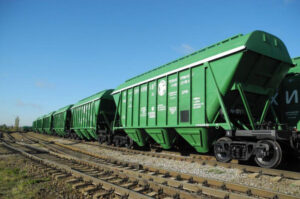
According to the ranking of the largest employers by region in Ukraine, compiled by OpenDataBot based on official reports from the State Statistics Service, Ukrzaliznytsia has been recognized as the largest employer in Kyiv and the entire country.
The largest employer in Ukraine with 178,616 employees. A state-owned railway company founded in 1991 on the basis of the infrastructure of the Ukrainian SSR. It is a monopoly in the railway transport market. It is part of the Ministry of Infrastructure of Ukraine. Its head office is in Kyiv.
Financial indicators: As of 2023, the company’s revenue exceeded UAH 95 billion. In 2024, the company was ranked among the top ten transport operators according to the OpenDataBot Index.
Activities: Provides passenger and freight transportation services and owns a railway network of over 19,000 km. The company is actively modernizing its rolling stock and introducing digital services.

The volume of grain transported by Ukrzaliznytsia in January-April 2025 decreased by almost 33% compared to the same period last year, to 10.092 million tons, according to Valery Tkachov, deputy director of the company’s commercial department.
“From January to April, 10.092 million tons of grain were transported by rail. Compared to last year, we have seen a decline in transportation of almost 33%, or 4.96 million tons,” Tkachov said at an online meeting with the agricultural market on Thursday.
According to him, one of the reasons for the decline is the large volumes of transportation in the first half of 2024, related to the operation of the “grain corridor,” which started in October 2023.
“Due to the fact that the ‘grain corridor’ began operating in October 2023, farmers did not have time to harvest their crops, and therefore these volumes were transferred to the first half of 2024,” Tkachev explained.
Another reason for the reduction in grain shipments by rail in 2025 is a slight decrease in the grain harvest.
The third reason is the lack of complete data in the system, as due to the cyberattack on March 23, shipping documents were issued in paper form for some time. On April 4, Tkachov reported that since the date of the cyberattack, shippers had issued more than 50,000 documents in paper form, and that this number had now been reduced to 4,000. He admitted that once all transport documents had been entered into the electronic system, the freight vertical’s performance indicators would be adjusted.
Of the 10.092 million tons of grain transported in January-April, 8.958 million tons were exported, with exports amounting to 2.76 million tons in January, 2.25 million tons in February, 1.68 million tons in March, and 1.1 million tons in April.
The volume of grain transported in the first 20 days of May amounted to 1.207 million tons, with an average daily load of approximately 73,000 tons.
At the same time, 89% of the grain transported by rail in May was destined for ports, compared to 92.6% in April and 90% in March. Only 10% of all grain transported for export went through western land crossings.
The situation is different for vegetable oil, with only 37.1% of the total volume transported to ports in May. In April, this figure reached 47.3%. The rest of the oil is transported through western land crossings. In total, 511.4 thousand tons of oil and 799.4 thousand tons of oilcake and meal were exported in the first four months of 2025.

Ukrzaliznytsia in 2024 reduced its operating profit from freight transportation by 2.3% compared to 2023 – to UAH 20.39 billion, while its operating loss from intercity, international, and suburban passenger transportation increased by 15.4% – to UAH 15.70 billion. According to the annual report available to Interfax-Ukraine, revenue from freight transportation last year increased by 10.3% to UAH 81.8 billion, while revenue from passenger transportation increased by 14.8% to UAH 10.67 billion.
As stated in the document, the largest operating profit in freight transportation was generated by the infrastructure component, which amounted to UAH 13.3 billion, up 8.3% from the previous year.
At the same time, the operating result of the rolling stock component decreased by 11.7% to UAH 6.93 billion, while that of the locomotive component fell almost fivefold to UAH 0.15 billion.
As for passenger transportation, the operating loss from intercity and international passenger transportation last year amounted to UAH 8.81 billion with revenue of UAH 10.67 billion, while suburban transportation lost UAH 9.31 billion with revenue of UAH 0.52 billion. In 2023, intercity and international passenger transportation brought an operating loss of UAH 7.46 billion with revenue of UAH 9.30 billion, while suburban transportation brought an operating loss of UAH 8.24 billion with revenue of UAH 0.56 billion.
Ukrzaliznytsia added that the operating result from auxiliary activities in 2024 amounted to UAH 2.99 billion, which is 3.7% less than the previous year, with revenue from these activities growing by 15.3% to UAH 9.78 billion.
In the report, the company noted that it is continuing its operational transformation and believes that further division into infrastructure, locomotive, and car components in the freight transportation segment, as well as disclosure of the infrastructure, locomotive, and car components in the intercity and international passenger transportation segment, is necessary for analyzing the company’s performance and further reorganization.
As reported, in 2024, the company increased its revenue by 11.1% to UAH 102.87 billion, but incurred a net loss of UAH 2.71 billion against a net profit of UAH 5.04 billion in 2023.
According to the Ministry of Economy, Ukrzaliznytsia provides more than 80% of freight and about 36% of passenger transportation within the country. The company is the largest employer in Ukraine with more than 190,000 employees and operates one of the largest railway networks in Europe, stretching over 19,000 km, of which more than 9,300 km are electrified. Ukrzaliznytsia has more than 1,400 stations and a significant fleet of locomotives, freight and passenger cars.

“Ukrzaliznytsia is launching an additional train to Truskavets from Kyiv, the company’s press service reports.
“Ukrzaliznytsia is launching the traditional additional train No. 159/160 Kyiv-Truskavets-Kyiv for the peak days of spring!” the statement said.
In particular, the dates of departure from Kyiv are expected to be April 25, 26, 27, and May 2, 3, 4. It is noted that the departure time is at 10:16. Arrival in Truskavets is at 19:37.
Meanwhile, the dates of departure from Truskavets are April 25, 26, 27, and May 2, 3, 4. Departure time is 09:03, arrival in Kyiv is 19:11.
There will be stops in Lviv and Drohobych.
Tickets can be purchased in the Ukrzaliznytsia app, at booking.uz.gov.ua or at railway ticket offices.